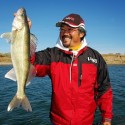By: Ted Takasaki and Scott Richardson
An exclusive interview with Lindy Rig inventor Ron Lindner
Ted Takasaki hoists a Lindy Rig-caught walleye. There would be no way to count the total number of walleyes caught on the famous Lindy Rig, but after reading the thoughts of inventor Ron Lindner, we hope you add to the total this season.
Many anglers have tried to improve the Lindy Rig over the years. But, no one does it better than the inventor.
Fishing legend Ron Lindner came up with the idea for the Lindy Rig more than 35 years ago, as he envisioned the most natural way to present live bait. Since then, it’s an even bet that Lindy Rigs have caught more walleyes than any other walleye technique.
The basic Lindy Rig was a flat-bottomed sinker, swivel, leader and hook in the mid-1960s. It was originally designed to fish on clean, sandy, clay, or gravel bottoms near Brainerd, Minnesota, where he and his equally famous brother, Al, were guides.
The first Lindy Rigs used 24-inch leaders of pink 6-pound line and pink #6 hooks.
Why the pink line? “We had a lot of it,” laughed Ron Lindner.
Why the pink hooks? “It worked,” he said. “It still does.”
The Lindy Rig offers several ways to modify the presentation. First is the sinker. Tradition calls for the lightest weight needed to reach the targeted depth while keeping a 45-degree angle with the water’s surface.
Not Lindner.
“When I invented it, I used to get clients to fish as straight up-and-down as possible,” he said. “I tended to use heavier sinkers. Where someone else might use a half-ounce, I’d used a three-quarter. I prefer to have more control of my bait.”
Lighter sinkers and a greater line angle to the surface works best in shallow water, where there is a fear of spooking fish, Ron said. The first commercially produced Lindy Rigs had 2-foot leaders. Later, that stretched to 3 feet. Some anglers extend leader length to 8 feet, 9 feet and even more. They claim it’s necessary to entice finicky fish. Lindner has an answer for that. “If they are that finicky, I do something else.”
In the beginning, Lindner used Lindy Rigs with a leader length of 6 inches to 1 foot. Still does. “I like the bait near the sinker,” he said. “I believe fish are attracted to the thumping (as you pump it). In effect, you’re fishing it like a jig.”
But, even with a short leader, the Lindy Rig offers two advantages over a jig. The first is that a rig allows the bait move more naturally in the water, he said. The second is that long waits to set the hook are unnecessary. “Shorter leaders require quick hook sets,” Lindner said.
With every rule come exceptions. Lindner lengthens leaders when his sonar reveals fish suspended off the bottom. “Walleyes will not go down for bait,” he said. His answer for finicky fish is hook size, not longer leaders. “The smaller the hook, the better,” he said.
On average, a #4 short-shanked hook works best with minnows and nightcrawlers. A #6 is good for leeches hooked directly through their sucker to allow them to swim. But, Lindner says, don’t hesitate to change up in order to see if a smaller hook produces more strikes.
For the die-hard, do-it-yourselfer, another modification to consider is leader diameter. Four-pound monofilament and a #10 hook may yield more strikes, he said. The problem then becomes actually landing the fish.
Evolution: Invention of the No-Snagg Sinker
It should come as no surprise to anybody that Ron Lindner is also the man behind the design for the NO-SNAGG sinker, intended to replace the original walking sinker when fishing through rocks and wood.
With the NO-SNAGG sinker, he advises, keep leader length on the short side. Sound can be added to the rig with the Rattlin’ NO-SNAGG sinker.
Try adding colored hooks, which includes Lindner’s favorites, pink or black nickel. Or, use tiny colored beads in front of the hook. Some people tie on a short piece of yarn. Colored snell floats are great to float your bait off the bottom.
“It’s been 36 years since the Lindy Rig went into commercial production,” Ron remembers. “Since then, it’s gone through a lot. But the Lindy Rig today is still one of the deadliest ways to fish live bait.”
After millions of fish caught by millions of fishermen, how can you go wrong?

